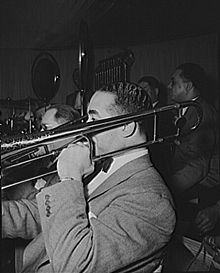Lawrence Brown (jazz trombonist)
Lawrence Brown | |
|---|---|
 Lawrence Brown in Duke Ellington's orchestra (1943) | |
| Background information | |
| Born | August 3, 1907 Kansas United States |
| Died | September 5, 1988 (aged 81) Los Angeles, California, United States |
| Genres | Jazz |
| Occupation(s) | Musician, Composer |
| Instrument | Trombone |
| Years active | 1932–70 |
| Labels | Clef Records, Impulse! Records |
Lawrence Brown (August 3, 1907 – September 5, 1988) was an acclaimed jazz trombonist from California who achieved recognition with the Duke Ellington orchestra.[1] Brown worked throughout his career as a session musician, as well as recording his own solo efforts.
Early life
Lawrence Brown was born on August 3, 1907, in Lawrence, Kansas. When Brown was about six or seven years old in 1914 his family moved to Oakland, California. He began playing the violin at a young age, but quickly grew tired of it and turned to playing the tuba in his school’s band.
Brown came from a musical background – his father was a preacher at the African American Episcopal church, where he often sang as a part of his sermons. Brown’s mother played the organ and the piano. Brown discovered the trombone while doing janitorial work at his father’s church. He stated that he wanted to replicate the sound of cello on a trombone.
Biography
Brown began his career with Charlie Echols and Paul Howard. In 1932 Brown joined Duke Ellington. His great technical command of the instrument, with its "creamy tone, neurotic vibrato and range" was featured with Ellington's band every year in compositions such as "Blue Cellophane" and "Golden Cress."
He left Ellington's band in 1951 to join a band led by former Ellington sideman Johnny Hodges, where he stayed until 1955. After leaving Hodges, Brown took a position for five years with CBS as a session player. In 1960, he rejoined Ellington and stayed with him until 1970. After leaving Ellington's band the second time at the age of 63, Brown quit performing completely.
He fulfilled many roles in the Ellington Orchestra—as a balladeer, technical soloist, and section leader. His highly melodic ballad playing as well as his fast technical style inspired trombonists from Tommy Dorsey to Bill Harris.
Brown was married to actress Fredi Washington. He died in Los Angeles, California.
Discography
- 1955: Slide Trombone Featuring Lawrence Brown (Clef Records)
- 1965: Inspired Abandon (Impulse! Records)
With Leonard Bernstein
- What is Jazz? (Columbia, 1956)
With Johnny Hodges
- Castle Rock (Norgran, 1951-52 [1955])
- In a Tender Mood (Norgran, 1952 [1955])
- The Blues (Norgran, 1952-54, [1955])
- Used to Be Duke (Norgran, 1954)
- Creamy (Norgran, 1955)
- Ellingtonia '56 (Norgran, 1956)
- Not So Dukish (Verve, 1958)
- Joe's Blues (Verve, 1965) with Wild Bill Davis
- Wings & Things (Verve, 1965) with Wild Bill Davis
References
External links
- ^ Steinman, Michael. "Beautifully Polished Brass". Jazz Lives. Retrieved May 21, 2015.
